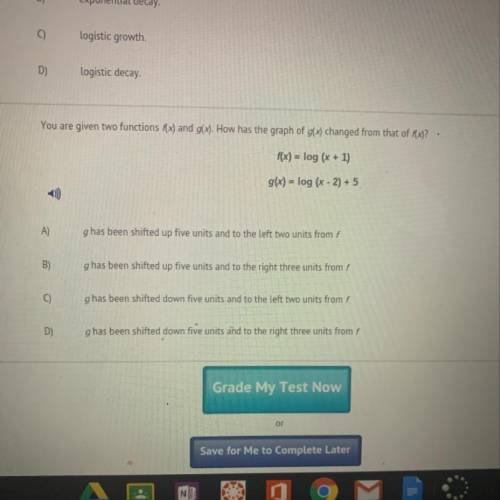
Mathematics, 19.06.2020 03:57 lawhornmakayla
You are given two functions f(x) and g(x). How has the graph of g(x) changed from that of Ax)?
f(x) = log (x + 1)
g(x) = log (x - 2) + 5
A)
g has been shifted up five units and to the left two units from f
B)
g has been shifted up five units and to the right three units from f
ghas been shifted down five units and to the left two units from F
D)
ghas been shifted down five units and to the right three units from F


Answers: 2


Other questions on the subject: Mathematics

Mathematics, 22.06.2019 00:30, babycakesmani
Jo divides a candy bar into eight equal pieces for her children to share she gives three pieces to sam three pieces to leslie and two pieces to margie rose the two month old baby does it doesn't get any what fraction shows how muchw candy each of the four children got. what's the answer to my question
Answers: 2


Mathematics, 22.06.2019 02:00, Dweath50
Look at this system of equations. -3x + 3y = 12 y = x + 4 the solution set of this system is best explained by which of these statements? a) the graphs of the equations are the same line because the equations have the same slope and the same y-intercept. the system has infinitely many solutions. b) the graphs of the equations are parallel lines because they have the same slope but different y-intercepts. the system has no solution. c) the graphs of the equations are lines that intersect at one point because the equations have the same slope but different y-intercepts. the system has exactly one solution. d) the graphs of the equations are lines that intersect at one point because the equations have the same slope and the same y-intercept. the system has exactly one solution.
Answers: 2

Mathematics, 22.06.2019 03:30, carjsan5656
Atechnician compares repair costs for two types of microwave ovens (type i and type ii). he believes that the repair cost for type i ovens is greater than the repair cost for type ii ovens. a sample of 6767 type i ovens has a mean repair cost of $79.79$79.79. the population standard deviation for the repair of type i ovens is known to be $19.18$19.18. a sample of 5555 type ii ovens has a mean repair cost of $75.24$75.24. the population standard deviation for the repair of type ii ovens is known to be $21.40$21.40. conduct a hypothesis test of the technician's claim at the 0.050.05 level of significance. let μ1μ1 be the true mean repair cost for type i ovens and μ2μ2 be the true mean repair cost for type ii ovens. step 2 of 4 : compute the value of the test statistic. round your answer to two decimal places.
Answers: 2
You know the right answer?
You are given two functions f(x) and g(x). How has the graph of g(x) changed from that of Ax)?
f(x)...
Questions in other subjects:

English, 15.01.2020 05:31


English, 15.01.2020 05:31


Mathematics, 15.01.2020 05:31

Mathematics, 15.01.2020 05:31



History, 15.01.2020 05:31




